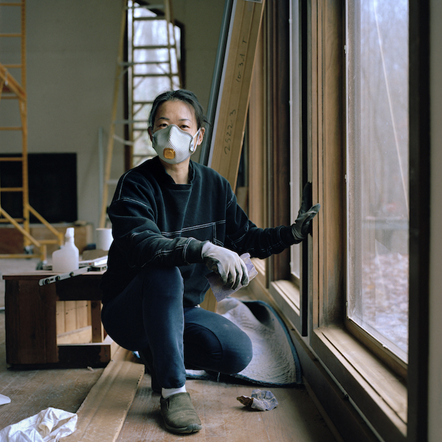By Tianlei (Ruby) Qiu, Class of 2024
Cici Cheng is a Chinese-born U.S. artist and photographer who grew up in Durham, North Carolina. She received an MFA in Experimental and Documentary Arts from Duke University and currently teaches Media and Arts at Duke Kunshan University. Additionally, she serves as a member of the CSCC Advisory Board and co-leads the China Stories & Images Cluster. Leaving her birthplace at the age of six to move to Durham with her family, Cici’s work focuses on personal and observational storytelling methods. Her narratives often revolve around intergenerational family relationships, the connection between place and identity, and the process of cultural assimilation. She believes home is “where we can imprint ourselves, our identities, our culture, our memories” and operationalizes her understanding through her work. Today, we have the opportunity to talk to Prof. Cheng to learn more about her personal trajectory and how she leverages media to express her feelings.
Could you please share with us what initially inspired you to embark on the CSCC Pilot Research Project “Art and Research: Photographing Communities Across the World“? Due the COVID-19, there were travel restrictions and lockdowns in 2022. How do you think the challenges you faced influenced your approach to photography and the overall direction of your project?

I’ve always been interested in people and different communities because I never had opportunities to travel while growing up. I got into art and learned to be creative in my hometown until I went to college in Los Angeles. I wanted to escape my familiar surroundings and explore new perspectives because all I knew was Durham, NC.
As a photographer, transitioning to working virtually was super challenging, especially during lockdowns. However, it became necessary. I ended up incorporating audio elements into my work to complement the images of individuals whom I photographed already. The audio elements were from interviews and they added more depth to my photographs, allowing viewers to become more engaged and immersed, particularly in portraits where the voices of the individuals depicted resonate alongside their images.
It’s important to maintain a genuine connection with the community members I work with, making sure they feel valued and respected beyond simply being subjects for my work. This required ongoing communication to show them my continued dedication to the project and collaboration with them, doesn’t matter if it’s in-person or virtually.
“Dear Yong An” is an interesting name! Could you please share the story behind the name of the exhibition and its significance to you personally and the project? The project also focuses on family history, intimacy, memory, and ethnography. Could you please share how you approach these personal and complex themes through your photography?
Yong An is my birthplace in China, a city that holds not only geographical significance but also represents my family’s history and the beginning of my life. Titling my exhibition “Dear Yong An” was my way of creating a feeling of intimacy and connection, as if I am writing a letter to my birthplace, my family, and the stories that have shaped me. I captured both the visible aspects of the environment and the importance of the community and its traditions.
Understanding my own identity was crucial before I could move on to make work in other communities for this project. What defines who we are and our sense of belonging? Through portraits and landscapes of Yong An, I wanted to depict the dynamic between memory and identity, as well as explore familial relationships and the concept of past and present. My photographs document not only the everyday moments but also the complexities of human relationships and self-identity.
We have learned that beyond photography, interviews are also a crucial part of your storytelling process. Engaging with communities to tell their stories might be a sensitive and intricate process. Could you share the strategies or approaches you employ to build trust with the people you photograph and interview?
It takes time. A lot of time, along with following your instincts. I’ve learned to step out of my comfort zone because I used to be so anxious and shy. But you can’t be that way when you’re trying to engage with others and learn from them. Everyone is different, and the way people communicate varies as well. You also have to feel—really feel—the environment and the people around you. I never force anyone to work with me or even talk to me if they don’t want to. If they don’t want their photo taken, I will kindly accept it because it’s important to, again, show them respect. After all, you are in their community, in their space.
Growing up as the only English speaker in your family, how has this shaped your perspective as a photographer, especially when engaging with communities worldwide? Could you please tell us in what ways you believe your unique background and personal story influence the narratives you choose to capture in your photography?
Growing up as the only English speaker in my family has made me more aware of how people communicate and connect. I had to teach myself various ways to communicate and understand others effectively. This included learning how to translate accurately and finding different ways to express ideas. This has greatly influenced my work, as I approach communities with openness and a desire to bridge cultural differences. I strongly believe in the power of listening and observing, which shapes how I tell their stories.
For aspiring photographers who might be facing similar challenges or who are interested in undertaking large-scale projects like yours, what advice would you offer them? Looking ahead, could you please share with us what the next steps are for you? Are there any new projects or directions you are currently exploring or planning to explore in the future?
There are days when progress on your project seems to be nonexistent, and then other days when you feel a surge of confidence, even adrenaline, that keeps you moving forward. It’s all part of the process. Sometimes, I’ll revisit my work and find a photograph that didn’t initially engage me now speaks volumes or gives me a stronger feeling than before. This fluidity is normal too. As artists, we evolve, and so does our work.
I’m really excited to return to the darkroom and start developing and printing again. It’s my happy place. There’s a special feeling of developing my own negatives, printing my images, and seeing a project through from start to finish. Right now, I’m still focused on documenting and collaborating with communities in Southeast China before moving up North, and at the same time, I’ll continue ongoing projects back in the States, one of them being centered around Asian American restaurant establishments in the South.


